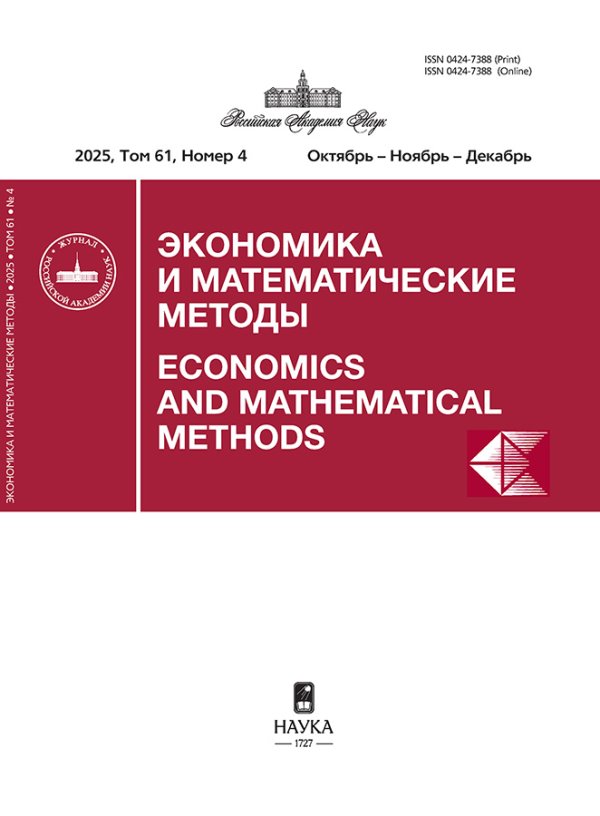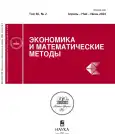Информационные войны современности и моделирование распространения новостей
- Авторы: Лосик И.В.1,2,3, Сидоренко С.В.4, Сидоренко М.Ю.4, Бахтизин А.Р.5,3
-
Учреждения:
- Телерадиокомпания ВС РФ «Звезда»
- Фонд сохранения культурно-исторической памяти героев войны «Наследники Победителей»
- МГУ имени М. В. Ломоносова
- Российская академия наук
- ЦЭМИ РАН
- Выпуск: Том 60, № 2 (2024)
- Страницы: 14-26
- Раздел: Теоретические и методологические проблемы
- URL: https://gynecology.orscience.ru/0424-7388/article/view/653298
- DOI: https://doi.org/10.31857/S0424738824020028
- ID: 653298
Цитировать
Полный текст
Аннотация
В работе рассматриваются информационные войны, являющиеся частью современных гибридных конфликтов. Их анализ проведен средствами компьютерных моделей, имитирующих процесс распространения информации в социальных сообществах. Типология наиболее релевантных и цитируемых инструментов позволила определить эффективный алгоритм для создания авторской агент-ориентированной модели, учитывающей индивидуальные особенности людей и позволяющей давать дифференцированную оценку влияния информационных сообщений на определенную группу. В рамках вычислительных экспериментов оценивалась скорость распространения информации в построенном цифровом двойнике социальной сети в зависимости от изменения числа лидеров мнений и изначально информированных агентов, а также от снижения среднего уровня репутации агентов сети. Построенный инструмент может использоваться самостоятельно, но также и в составе более сложных моделей, включающих демографическую и экономическую составляющие.
Полный текст
Об авторах
И. В. Лосик
Телерадиокомпания ВС РФ «Звезда»; Фонд сохранения культурно-исторической памяти героев войны «Наследники Победителей»; МГУ имени М. В. Ломоносова
Автор, ответственный за переписку.
Email: iralosiknews@mail.ru
ведущая вечерних новостей «Итоги дня» телерадиокомпании ВС РФ «Звезда», Фонд сохранения культурно-исторической памяти героев войны «Наследники Победителей», аспирант факультета ВШГА МГУ имени М. В. Ломоносова
Россия, МоскваС. В. Сидоренко
Российская академия наук
Email: sidor@presidium.ras.ru
Управление научно-методического руководства и экспертной деятельности
Россия, МоскваМ. Ю. Сидоренко
Российская академия наук
Email: myusidorenko@pran.ru
Управление научно-информационной деятельности РАН и взаимодействия с научно-образовательным сообществом, Научно-издательский совет
Россия, МоскваА. Р. Бахтизин
ЦЭМИ РАН; МГУ имени М. В. Ломоносова
Email: albert.bakhtizin@gmail.com
член-корреспондент РАН
Россия, МоскваСписок литературы
- Акопов А. С., Бекларян Л. А., Бекларян А. Л. (2021). Мультисекторная модель ограниченного соседства: сегрегация агентов и оптимизация характеристик среды // Математическое моделирование. Т. 33. № 11. С. 95– 114. doi: 10.20948/mm-2021-11-06 [Akopov A. S., Beklaryan L. A., Beklaryan A. L. (2021). Multisector bounded-neighborhood model: Agent segregation and optimization of environment’s characteristics. Matematicheskoe Modelirovanie, 33, 11, 95–114. doi: 10.20948/mm-2021-11-06 (in Russian); Akopov A. S., Beklaryan L. A., Beklaryan A. L. (2022). Multisector bounded-neighborhood model: Agent segregation and optimization of environment’s characteristics. Mathematical Models and Computer Simulations, 14, 3, 503–515. doi: 10.1134/S2070048222030024 (in English).]
- Губанов Д. А. (2021). Модели и методы информационного влияния и управления в активных сетевых структурах. Дис. … уч. степ. докт. техн. наук. М.: ИПУ РАН. 307 с. [Gubanov D. A. (2021). Models and methods of information influence and management in active network structures. Dissertation for the degree of Doctor of Technical Sciences Moscow: Institute of Control Sciences RAS. 307 p. (in Russian).]
- Мачуева Д. А., Ажмухамедов И. М. (2018). Моделирование процесса информационного взаимодействия в социальных системах // Системы управления, связи и безопасности. № 2. С. 18–39. Режим доступа: http://sccs.intelgr.com/archive/2018-02/02-Machueva.pdf [Machueva D. A., Azhmuhamedov I. M. (2018). Modeling the information interaction process social systems. Systems of Control, Communication and Security, 2, 18–39. Available at: http://sccs.intelgr.com/archive/2018-02/02-Machueva.pdf (in Russian).]
- Adämmer P., Schüssler R. A. (2019). Forecasting the equity premium: Mind the news. Review of Finance. Forthcoming. SSRN: 3370424. doi: 10.2139/ssrn.3370424
- Arruda H. F., Cardoso F. M., Arruda G. F., Hernandez A. R., Costa L. D., Moreno Y. (2022). Modelling how social network algorithms can influence opinion polarization. Information Sciences, 588, 265–278. ISSN: 0020-0255. doi: 10.1016/j.ins.2021.12.069
- Bass F. (1969). A new product growth for model consumer durables. Management Science, 15 (5), 215–227. doi: 10.1287/mnsc.15.5.215
- Beklaryan A. L., Beklaryan L. A., Akopov A. S. (2022). Implementation of the deffuant model within the FLAME GPU framework. Advances in Systems Science and Applications, 21, 4, 87–99. doi: 10.25728/assa.2021.21.4.1161
- Bruine de Bruin W., Parker A. M., Strough J. (2020). Age differences in reported social networks and well-being. Psychology and Aging, March, 35 (2), 159–168. doi: 10.1037/pag0000415
- Cai M., Luo H., Meng X. et al. (2022). Influence of information attributes on information dissemination in public health emergencies. Humanities Social Sciences Communications, 9, 257. doi: 10.1057/s41599-022-01278-2
- Calomiris C. W., Mamaysky H. (2019). How news and its context drive risk and returns around the world. Journal of Financial Economics, 133, 2, 299–336. doi: 10.1016/j.jfineco.2018.11.009
- Gonçalves B., Perra N., Vespignani A. (2011). Modeling users’ activity on twitter networks: Validation of Dunbar’s number. PLoS One, 6 (8), e22656. doi: 10.1371/journal.pone.0022656 Available at: https://www.ncbi.nlm.nih.gov/pmc/articles/PMC3149601
- Hong Y., Jiang F., Meng L., Xue B. (2022). Forecasting inflation with economic narratives and machine learning. SSRN: https://ssrn.com/abstract=4175749 or doi: 10.2139/ssrn.4175749
- Kumar N. (2019). Information diffusion and summarization in social networks. A thesis submitted to Indian institute of technology Hyderabad in partial fulfillment of the requirements for the degree of doctor of philosophy. Hyderabad: Indian Institute of Technology. Available at: https://core.ac.uk/reader/224956800
- Kumar P., Sinha A. (2021). Information diffusion modeling and analysis for socially interacting networks. Social Network Analysis and Mining, 11, 1. doi: 10.1007/s13278-020-00719-7
- Kumar S., Saini M., Goel M. et al. (2021). Modeling information diffusion in online social networks using a modified forest-fire model. Journal of Intelligent Information Systems, 56, 355–377. doi: 10.1007/s10844-020-00623-8
- Larsen V. H., Thorsrud L. A., Zhulanova J. (2021). News-driven inflation expectations and information rigidities. Journal of Monetary Economics, 117, 507–520. doi: 10.1016/j.jmoneco.2020.03.004
- Li M., Wang X., Gao K., Zhang S. (2017). A survey on information diffusion in online social networks: Models and methods. Information, 8, 118. doi: 10.3390/info8040118
- Liu L., Qu B., Chen B., Hanjalic A., Wang H. (2018). Modeling of information diffusion on social networks with applications to WeChat. Physica A: Statistical Mechanics and its Applications, 496, 318–329. doi: 10.1016/j.physa.2017.12.026
- Pond T., Magsarjav S., South T., Mitchell L., Bagrow J. P. (2020). Complex contagion features without social reinforcement in a model of social information flow. Entropy, 22 (3), 265.
- Qiang Z., Pasiliao E. L., Zheng Q. P. (2019). Model-based learning of information diffusion in social media networks. Applied Network Science, 4. Article number: 111. doi: 10.1007/s41109-019-0215-3
- Rand W., Herrmann J., Schein B., Vodopivec N. (2015). An agent-based model of urgent diffusion in social media. Journal of Artificial Societies and Social Simulation, 18 (2), 1. doi: 10.18564/jasss.2616 or Available at: http://jasss.soc.surrey.ac.uk/18/2/1.html
- Rand W., Rust R. T. (2011). Agent-based modeling in marketing: Guidelines for rigor. International Journal of Research in Marketing, 28 (3), 181–193. doi: 10.1016/j.ijresmar.2011.04.002
- Razaque A., Rizvi S., Khan M. J., Almiani M., Rahayfeh A. A. (2022). State-of-art review of information diffusion models and their impact on social network vulnerabilities. Journal of King Saud University — Computer and Information Sciences, 34, 1, 1275–1294. ISSN: 1319–1578. doi: 10.1016/j.jksuci.2019.08.008 or Available at: https://www.sciencedirect.com/science/article/pii/S131915781930388X
- Röchert D., Cargnino M., Neubaum G. (2022). Two sides of the same leader: An agent-based model to analyze the effect of ambivalent opinion leaders in social networks. Journal of Computational Social Science, 5, 1159–1205. doi: 10.1007/s42001-022-00161-z
- Schawe H., Beiró M. G., Alvarez-Hamelin J.I. et al. (2023). Understanding who talks about what: Comparison between the information treatment in traditional media and online discussions. Sci. Reports, 13, 3809. doi: 10.1038/s41598-023-30367-8
- Vosoughi S., Roy D., Aral S. (2018). The spread of true and false news online. Science, Mar, 359, 6380, 1146–1151. doi: 10.1126/science.aap9559
- Wang Y., Li G. (2018). The spreading of information in online social networks through cellular automata. Complexity, 1–9. doi: 10.1155/2018/1890643
Дополнительные файлы














